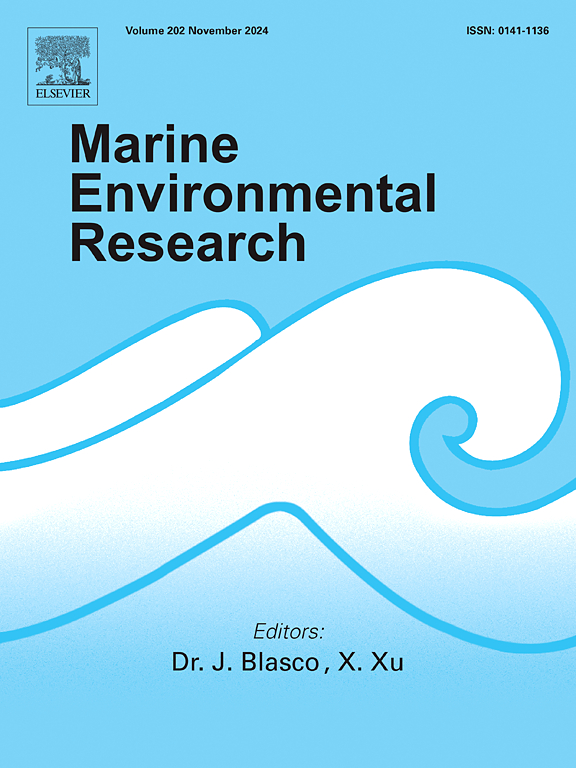Numerical modelling of radionuclide uptake by bluefin tuna along its migration routes in the Mediterranean Sea after a nuclear accident
IF 3
3区 环境科学与生态学
Q2 ENVIRONMENTAL SCIENCES
引用次数: 0
Abstract
A numerical model which simulates the adsorption of radionuclides by migrating bluefin tuna in the Mediterranean Sea is described, in order to determine the level of contamination of these fish after a hypothetical nuclear accident and thus be able to assess the possible impact on human consumption. A 4–species foodweb model is incorporated into a Lagrangian model describing physical transport (advection, mixing, radioactive decay and interactions of radionuclides with sediments). Tuna is the last trophic level in the foodweb model and the equation providing the temporal evolution of radionuclide concentration in its flesh is solved along the fish trajectories, which were obtained through electronic tagging of fishes. The model was applied to the western Mediterranean, where several worst–case hypothetical accidents were simulated, both from a coastal nuclear power plant and from a vessel. Resulting 137Cs concentrations in migrating tuna were similar, or slightly higher, than reported background concentrations in these fishes and well below established safety levels. Maximum calculated concentrations in tuna flesh is in the order of 1 Bq/kg (wet weight). This is due to the rapid movement of the fishes, which spend only limited time over the most contaminated spots.
核事故后蓝鳍金枪鱼沿地中海洄游路线吸收放射性核素的数值模拟
介绍了模拟地中海洄游蓝鳍金枪鱼对放射性核素吸附的数值模型,以确定假定核事故发生后这些鱼类的污染程度,从而能够评估对人类消费可能产生的影响。在描述物理迁移(平流、混合、放射性衰变以及放射性核素与沉积物的相互作用)的拉格朗日模型中纳入了 4 种食物网模型。金枪鱼是食物网模型中的最后一个营养级,其鱼肉中放射性核素浓度的时间演变方程是沿着鱼的运动轨迹求解的,这些轨迹是通过鱼的电子标签获得的。该模型应用于地中海西部,模拟了来自沿海核电厂和船只的几种最坏情况假设事故。结果显示,洄游金枪鱼体内的 137Cs 浓度与报告的这些鱼类体内的本底浓度相似或略高,远低于既定的安全水平。金枪鱼鱼肉中的最大计算浓度约为 1 Bq/kg(湿重)。这是因为金枪鱼的移动速度很快,在污染最严重的地方停留的时间有限。
本文章由计算机程序翻译,如有差异,请以英文原文为准。
求助全文
约1分钟内获得全文
求助全文
来源期刊

Marine environmental research
环境科学-毒理学
CiteScore
5.90
自引率
3.00%
发文量
217
审稿时长
46 days
期刊介绍:
Marine Environmental Research publishes original research papers on chemical, physical, and biological interactions in the oceans and coastal waters. The journal serves as a forum for new information on biology, chemistry, and toxicology and syntheses that advance understanding of marine environmental processes.
Submission of multidisciplinary studies is encouraged. Studies that utilize experimental approaches to clarify the roles of anthropogenic and natural causes of changes in marine ecosystems are especially welcome, as are those studies that represent new developments of a theoretical or conceptual aspect of marine science. All papers published in this journal are reviewed by qualified peers prior to acceptance and publication. Examples of topics considered to be appropriate for the journal include, but are not limited to, the following:
– The extent, persistence, and consequences of change and the recovery from such change in natural marine systems
– The biochemical, physiological, and ecological consequences of contaminants to marine organisms and ecosystems
– The biogeochemistry of naturally occurring and anthropogenic substances
– Models that describe and predict the above processes
– Monitoring studies, to the extent that their results provide new information on functional processes
– Methodological papers describing improved quantitative techniques for the marine sciences.
 求助内容:
求助内容: 应助结果提醒方式:
应助结果提醒方式:


